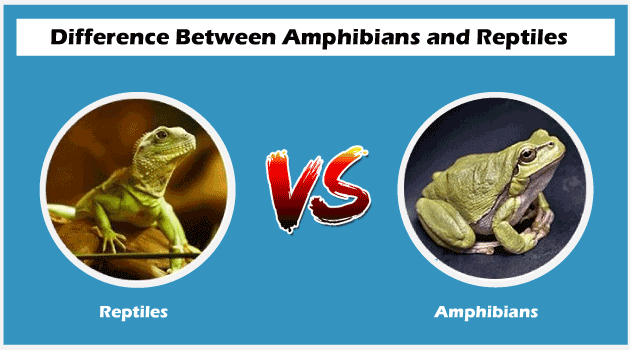Difference between Amphibians and ReptilesAnimals are classified under several categories: herbivores, carnivores, reptiles, amphibians, insects, omnivores, etc. These are just some of the classifications. Nature has given us a variety of creatures. Humans are just one type of creature differentiated by their behavior, attitude, habits, etc. But animals are one such species that are distinguished based on their looks, appearance, eating habits, etc. The fundamental difference between them is of their appearance. Some animals live in water, some on land, and some in both. So today, we will be discussing about two significant kinds of animals, i.e., amphibians and reptiles. Amphibians and reptiles have some major contrasting points between them, which we will be discussing later. Before that, let us focus on knowing the primary meaning of these terms. 
AmphibiansAmphibians are defined as small vertebrates that need a moist environment for sustenance. Examples of amphibians include toads, frogs, salamanders, etc. Amphibians are capable of absorbing water and breathing through their skin. Amphibians come from the category called 'amphibia,' which are cold-blooded animals. These animals generally have soft and moist skin. The most common types of amphibians are toads, frogs, salamanders, caecilians, etc. The major characteristics of amphibians are that they have external egg fertilization, are cold-blooded, they have vertebrates, etc. According to some sources, Ichthyostega was the first amphibian found on the planet. This creature was found in Greenland about 300 million years ago. Another amphibian called Elginerpeton was also discovered 360 million years ago. Now, amphibians have been known to survive in various habitats. They are found in forests, meadows, rivers, streams, lakes, etc. They can adapt themselves to any kind of habitat. They are even seen surviving in the farmlands. Well, according to some sources, around 168 species of amphibians have already gone extinct, and the present rates are declining as well. Amphibians are known to live for about 300 million years, but they are alarmingly on the verge of decline. ReptilesReptiles are defined as cold-blooded creatures who have scales in their body with which they can move. These are air-breathing vertebrates. Examples of reptiles include snakes, turtles, crocodiles, tortoises, lizards, etc. Reptiles have a slow metabolism, and they seek heat. These creatures give birth by laying eggs, and they feed on other animals for their survival. They majorly live on land because they need heat for sustenance. Some of the significant characteristics of reptiles are that they produce shelled eggs, are covered with scales, are cold-blooded, and have at least one lung for breathing. Reptiles are known to have dry skin, which protects them from having fatal injuries. Saltwater reptiles are the largest living reptiles on earth. They are 23 feet long and weigh over 2300 pounds. Reptiles are found everywhere except for Antarctica. Reptiles live in various habitats, but majorly they reside in oceans, seas, etc. Some reptiles like lizards are terrestrial, so they are found in deserts, trees, rainforests, etc. Hylonomus was the first reptile having a length of 20-30 cm. Now, let us discuss about some of the contrasting points between reptiles and amphibians.
So, these are some of the significant contrasting points between amphibians and reptiles. Now, both amphibians and reptiles have several characteristics through which they can survive under harsh conditions. So, let us take a look at them. Characteristics of Amphibians
Characteristics of Reptiles
So, these are some of the characteristics of amphibians and reptiles. Both reptiles and amphibians can be found in several habitats. The major difference between them is that the reptiles live on land and amphibians live in water as well as on land. But unfortunately, both these species are on the verge of extinction. Therefore, it is essential to save them because they contribute to flora and fauna in their own way. Thus, amphibians and reptiles are some of the extinct but important creatures of the planet.
Next TopicDifference between
|
 For Videos Join Our Youtube Channel: Join Now
For Videos Join Our Youtube Channel: Join Now
Feedback
- Send your Feedback to [email protected]
Help Others, Please Share










